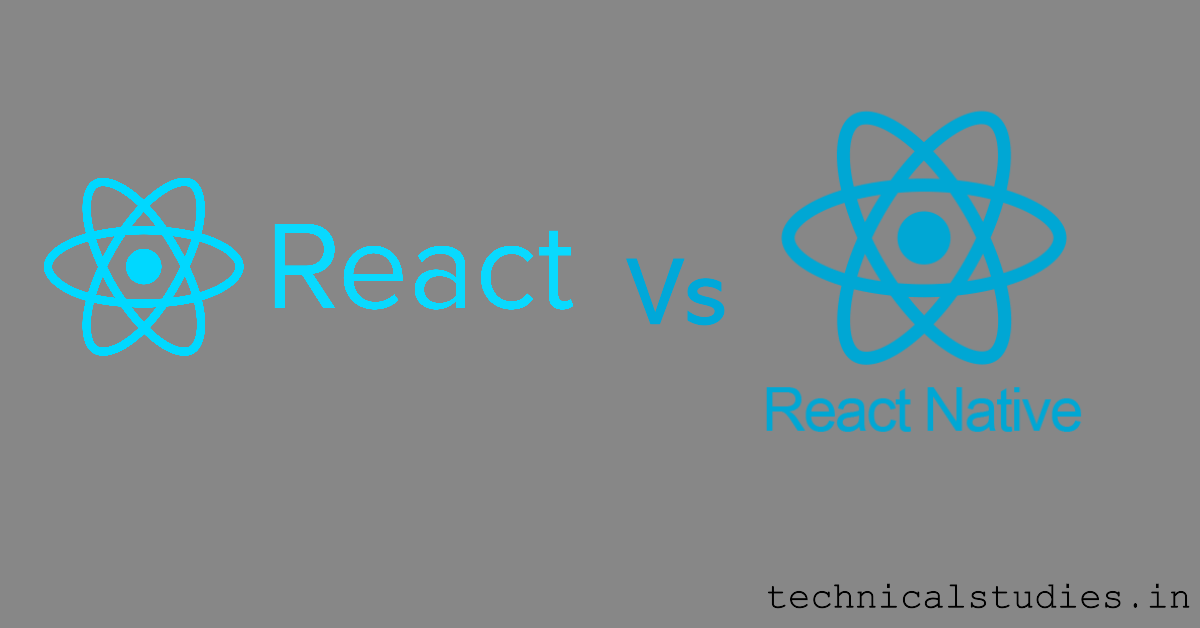Last updated on April 12th, 2025 at 10:23 pm
React and React Native are two JavaScript frameworks popularly used to build different applications. In this post, we will discuss various aspects of React vs React Native so that you can understand the fundamentals of both and choose the right tool for your projects.
When I was new to web development, I used to presume that ReactJS and React Native were the same thing with different names. Later on, I understood the difference and where to use which one.
Assuming that both are the same is not uncommon for a newcomer, but it is also crucial to understand the differences and similarities they have.
In this post, I will discuss React and React Native, highlighting their differences and similarities. This will give you proper knowledge about both technologies so that you can make an informed decision.
Understanding The Basics
Before going into the basics of React and React Native, let’s take a moment to discuss website rendering principles.
It starts with a user entering a URL in the search bar of a web browser. Then, the browser requests the web page from the hosting server. The server sends an HTML file containing the content of the webpage and related CSS and JavaScript files.
Upon receiving, the browser parses the HTML file and creates a Document Object Model, organizing all the page’s elements, such as paragraphs, images, links, buttons, etc.
The browser parses the linked CSS and JavaScript files and applies the settings to the DOM. After processing all files, the browser displays the webpage on the screen.
One issue with inserting elements into DOM with JavaScript is that the code is not reusable. If you want to make some changes to the UI, you have to write that code again for that particular element. This can become a major problem with complex coding environments.
This is where the role of ReactJS comes in. It is designed to facilitate simple customization and streamline the process of developing UI elements.
With ReactJS, you don’t have to write the entire code to make some changes to an element. You can easily re-use the element in other parts of the code while making necessary changes.
What is React?

React is an open-source, powerful, front-end javascript library designed by Facebook to create user interfaces and UI elements. It was developed in 2011 and made public in 2013.
With the React library, you can build a complete website with an attractive user interface that can be accessed through a web browser. The main benefit of using React is it simplifies the development process with reusable elements.
React allows you to create reusable elements that you can use in any part of the website or app. As I mentioned above, this is not possible with JavaScript.
Its architecture is component-based, which allows you to define a component first and customize its properties on the website as needed. For instance, you can define a component or element <Button> and pass different colors to it as props.
This makes the coding easier and adds effectiveness to the web development process. Overall, React is an innovative tool that can simplify the front-end development process.
Advantages and disadvantages of React
Let’s now discuss the advantages and disadvantages of React.
Advantages of React
- React creates a virtual DOM to update only the required part of the UI component for optimized performance.
- Its architecture is component-centric, where the code is divided into reusable components for better organization and maintenance.
- With JSX, React provides a combined syntax of JavaScript and HTML-like elements, making the development process streamlined.
- React.js also has the advantage of declarative syntax, which reduces boilerplate code and makes it easier to understand.
- Creating dynamic web applications is easy with React because of less coding and enhanced performance.
- React library helps build SEO-friendly applications, helping websites index faster. With optimized SEO, it helps website owners get more leads.
- React has an active and extensive community with innumerable learning resources.
- With server-side rendering, React advances the loading speed of a web page. This helps in SEO and the success of your business or website.
Disadvantages of React
React has several disadvantages as well. Let’s have a look at the drawbacks of React.
- The first drawback of React is that it has a steeper learning curve. It can be challenging for programmers who are new to JavaScript or component-themed architecture.
- As mentioned above, the virtual DOM feature of React optimizes the application for better performance and speed. However, there can be performance issues if it is not optimized properly.
- JSX can be challenging for users who want to use traditional JavaScript syntax.
- Due to advancements in technology and frequent updates, developers may feel overloaded.
- State management in complex React applications can be difficult, but other technologies can help, including Redux or MobX API.
Where is React used?
As an efficient javascript library, React is primarily used to build user interfaces and single-page web applications.
React is used for various applications in web development, for instance, creating reusable UI components, handling dynamic content updates without reloading the page, managing the state of applications, etc.
React.js is used to build e-commerce websites for better interactivity and responsiveness. It streamlines the processes of an e-commerce website, such as governing large-scale catalogs, filtering products, and providing a seamless checkout experience.
React’s component-based architecture and scalability make it suitable for creating enterprise and social media applications. It can handle complex user interfaces and manage real-time data efficiently.
In addition, React is favored for building progressive web apps, content management systems, data visualization tools, etc.
Also Read:
What is React Native?

React Native is an open-source app development framework that combines the usefulness of the React library and the power of native app development. It is designed by Facebook to help build mobile applications using React and JavaScript.
A plus point of React Native is it allows you to build applications for Android, iOS, and Windows using a single codebase, i.e., JavaScript. This enables javascript developers to enter the mobile app development process using their current skills.
With React Native, you will use your React.js skills and native components to build mobile applications for Android and iOS platforms. Since its initial release in 2015, thousands of mobile applications have been built using this technology.
Advantages of React Native
- React Native supports cross-platform development, allowing you to create mobile applications for Android and iOS devices using a single code base. As a result, you can save time and money required for creating and maintaining multiple codes. However, a little adjustment is needed to deploy applications to different platforms.
- Like React.js, React Native uses component-based architecture. This allows you to build reusable components and use them to create complex user interfaces. In addition, it adds flexibility to the development process.
- Hot reloading is a feature offered by React Native that visualizes the recent changes in the code without reloading the entire application. This will allow you to see the outcome quickly and proceed with further development.
- React Native is backed by a supportive community with plenty of resources. As a React Native developer, you can get answers to all the issues you face from this community.
- You can access native APIs with React Native, which gives access to GPU, camera, microphone, and other hardware features. In addition, you can also write code in a specific language (Objective C or Swift for Android and Kotlin or Java for Android) if you want.
- The React Native framework forms a communication bridge between javascript and native components, providing almost native-like performance across Android and iOS platforms.
Disadvantages of React Native
- While React Native offers superb performance, its speed and responsiveness may not match the responsiveness of naive apps in case of complex and heavy computation tasks.
- Debugging React Native apps can be challenging since you have to deal with JavaScript and native code.
- Those who don’t have a JavaScript background might find it hard to learn React Native. However, JavaScript developers will find it easy to learn React Native.
- Since it is an open-source framework, there might be security concerns with delicate applications.
Where is React Native used?
React Native is primarily used to build mobile applications for Android and iOS platforms in various categories. Now, let’s discuss where you can use React Native.
Facebook uses React Native to manage some features in Facebook and Instagram apps. Facebook’s Facebook Ads Manager is built using React Native.
E-commerce platforms like Walmart and Shopify use React Native for a seamless user experience. Its cross-platform capability and intuitive interface help in managing stores using mobile devices.
React Native is also used in entertainment and content streaming apps. Netflix uses it to build certain UI components and internal tools to streamline the development process.
SoundCloud Plus was built using React Native. This is a partner app of SoundCloud that helps creators manage their accounts and connect with their audience.
In addition, React Native is used for the development and maintenance of UI elements in various fields such as travel & hospitality, finance & banking, news and media, startups, education, health & fitness, etc.
React Native is a superior choice for small and large enterprises for mobile app development due to its ease of use and native-like performance.
The difference between React and React Native
Although React and React Native have React in their names, their core purposes differ. React’s core purpose is to create user interfaces for web applications and build single-page applications with interactive features.
On the other hand, React Native is a framework that combines React and native app development to provide a near-native experience and develop mobile applications using a single codebase. It allows you to create mobile applications for Android and iOS platforms using React and JavaScript.
Comparing React and React Native in a tabular view
Here, we will discuss subtle differences between React and React Native and tabulate them for easy interpretation.
| Aspects | React | React Native |
| Used for | React is primarily used to design interactive user interfaces for web applications. | It is popular for building cross-platform mobile applications for Android and iOS platforms. |
| Core technology | React is basically a JavaScript library that requires JavaScript coding. | React Native is an app development framework that merges JavaScript with native programming languages like Java, Swift, etc., to let you build user interfaces for mobile platforms. |
| Efficiency | Featuring server-side rendering and client-side execution, React enhances overall efficiency. It is beneficial for both low-level and high-level UI components. | React Native features reusable native components that are compatible with native code, contributing to the overall efficiency. |
| SEO and compatibility | React focuses on SEO and offers several tools for SEO optimization. It supports server-side rendering to support faster indexing of web pages. | React Native only focuses on building UI elements for mobile devices and has nothing to do with SEO. |
| Platform | Web browsers | Android and iOS mobile devices |
| Rendering Technology | React.js renders the code from virtual DOM to update the UI. | React Native renders native components using APIs on the mobile platform. |
| Styling options | React uses CSS or preprocessors like SASS for styling. | React Native uses JavaScript-based stylesheets for styling activities. |
| Components | It has class and function components such as <div>, <h1>, <spin>, etc. for better performance and readability. | React Native uses native components and modules to develop apps with native functionality. |
| Navigation system | It uses the React router for navigation in web apps. | It can use the React Native navigation system or a navigation library to transition screens in mobile apps. |
| Third-party library | React boasts a comprehensive ecosystem of various tools and libraries for web development. | React Native usually needs a custom library designed for mobile platforms. |
| Development Tools | React uses various development tools such as VS Code, Babel, ESLint, Webpack, and browser dev tools. | Tools like Expo, React Native CLI, Android Studio, Xcode, and Metro are used in React Native. |
| Performance | The performance of a React.js web application depends on the browser and network performance. | React Native applications provide near-native performance. It may need native modules for complex tasks. |
| Learning curve | You won’t face any challenges in learning React if you are familiar with javascript, HTML, and CSS. | To learn React Native, you should understand the concepts of mobile development and be familiar with React. |
| Deployment | React apps are deployed to web servers and can be accessed via web browsers. | React Native apps are deployed to the Google Play Store for Android and the App Store for iOS. |
| Library or framework | React is a javascript library that focuses on creating user interfaces for web applications. | React Native is an end-to-end application development framework with certain APIs and components for mobile app development. |
Should you learn React or React Native?
I can’t answer this question directly as it depends on various factors. Your project requirements, platform, and purpose will determine whether React or React Native will be suitable for your application.
You should go with React if you want to work on web applications and build single-page web applications. You can design interactive web pages with improved SEO using React.js.
However, React Native will be ideal for you if you want to work on the mobile platform. It will help you deploy mobile applications to iOS and Android platforms by writing a single code.
Another thing to keep in mind is that React and React Native are related to each other, so you can easily understand React Native if you learn React and vice versa.
I would recommend learning React first and proceeding with React Native if you need to.
Conclusion
In this article, we have explored the basics of React and React Native along with their advantages and disadvantages. We have also understood the key difference between these two technologies and their use cases.
I hope you have gained proper knowledge about these two technologies and comprehended when to use which one. Also, consider sharing this article with your colleagues and friends to help them decide when to use React vs React Native.
FAQ
Is React Native harder than React?
Yes, compared to React.js, React Native is a bit complex. This is due to its additional features, such as cross-platform development capabilities and the combination of JavaScript and native platforms.
Can I convert ReactJS to React Native?
Yes, you can convert a React.js application to a React Native application because both technologies use similar concepts. However, it won’t be direct as their platforms are different, and you have to make the necessary changes to convert it.
Should I learn Flutter or React Native in 2024?
It depends on your expertise, goals, and the project you want to work on. If you are familiar with the JavaScript or React ecosystem and wish to proceed with mobile app development using your existing skills, you should choose React Native. If you are new to mobile development and ready to learn the Dart language for this, you can go with Flutter.
Does React Native use NodeJs?
Yes, React Native uses NodeJs as a backend application. However, it is not used directly since React Native runs on native code.
Should I learn both React and React Native?
It depends on your specific requirements. If you are interested in developing web and mobile applications, learning React and React Native will benefit you.
Which big company uses React Native?
Many popular companies use react native to develop and manage their mobile applications. This includes Facebook, Instagram, Walmart, Microsoft, Bloomberg, Uber, Airbnb, Discord, Shopify, Pinterest, Wix, Uber Eats, SoundCloud, etc.
Related Articles
Discover more from technicalstudies
Subscribe to get the latest posts sent to your email.




